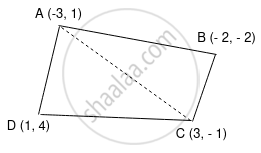Advertisements
Advertisements
Question
Find the area of quadrilateral whose vertices are
A(−3, 1), B(−2, −2), C(3, -1), D(1, 4)
Solution
A(−3, 1), B(−2, −2), C(3, -1), D(1, 4)

A(`square`ABCD) = A(ΔABC) + A(ΔACD)
Area of a triangle = `1/2|("x"_1,"y"_1,1),("x"_2,"y"_2,1),("x"_3,"y"_3,1)|`
A(ΔABC) = `1/2|(-3, 1, 1),(-2, -2, 1),(3, -1, 1)|`
= `1/2[-3(-2 - (- 1)) - 1(-2 - 3) + 1(2 - (- 6))]`
= `1/2[-3(-2 + 1) - 1(-2 - 3) + 1(2 + 6)]`
= `1/2[-3(-1)-1(-5)+1(8)]`
= `1/2 ( 3 + 5 + 8)`
= `1/2(16)`
∴ A(ΔABC) = 8 sq. units
A(ΔACD) = `1/2|(-3, 1, 1),(3, -1, 1),(1, 4, 1)|`
= `1/2[-3(-1-4)-1(3-1)+1(12 - (- 1))]`
= `1/2[-3(-5)-1(2)+1(13)]`
= `1/2(15-2+13)`
= `1/2(26)`
∴ A(ΔACD) = 13 sq. units
∴ A(`square`ABCD) = A(ΔABC) + A(ΔACD)
= 8 + 13
= 21 sq. units
APPEARS IN
RELATED QUESTIONS
Find the area of triangle whose vertices are
A(5, 8), B(5, 0) C(1, 0)
Find the area of triangle whose vertices are
`"P"(3/2, 1), "Q"(4, 2), "R"(4, (-1)/2)`
Find the area of triangle whose vertices are
M(0, 5), N(−2, 3), T(1, −4)
Find the value of k, if the area of triangle whose vertices are P(k, 0), Q(2, 2), R(4, 3) is `3/2 "sq.unit"`
Examine the collinearity of the following set of point:
A(3, −1), B(0, −3), C(12, 5)
Examine the collinearity of the following set of point:
P(3, −5), Q(6, 1), R(4, 2)
Examine the collinearity of the following set of point:
`"L"(0, 1/2), "M"(2, -1), "N"(-4, 7/2)`
Select the correct option from the given alternatives:
If A(0,0), B(1,3) and C(k,0) are vertices of triangle ABC whose area is 3 sq.units then value of k is
Answer the following question:
Find the area of triangle whose vertices are A(−1, 2), B(2, 4), C(0, 0)
Answer the following question:
Find the area of triangle whose vertices are P(3, 6), Q(−1, 3), R(2, −1)
Answer the following question:
Find the value of k:
If area of triangle is 4 square unit and vertices are P(k, 0), Q(4, 0), R(0, 2)
Answer the following question:
Find the value of k:
If area of triangle is `33/2` square unit and vertices are L(3, −5), M(−2, k), N(1, 4)
Answer the following question:
Find the area of quadrilateral whose vertices are A(0, −4), B(4, 0), C(−4, 0), D(0, 4)
Answer the following question:
Show that the following points are collinear by determinant:
L(2,5), M(5,7), N(8,9)
Answer the following question:
Show that the following points are collinear by determinant:
P(5,1), Q(1,−1), R(11,4)
